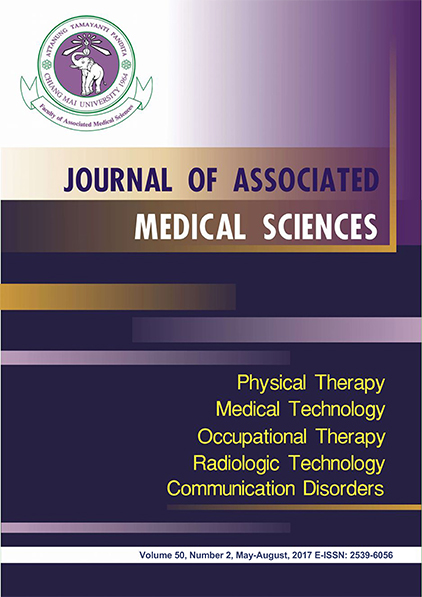Effects of pelvic floor exercises on the quality of life in incontinent women
Main Article Content
Abstract
Background: Urinary incontinence (UI) in women increases with increasing age and negatively affects quality of life. Pelvic floor exercise is one of a method for UI prevention and intervention as well as improve quality of life. However, study of effects of pelvic floor exercises on the quality of life in community-based incontinent women is limited.
Objectives: To examine the effects of pelvic floor exercise (PFx) on the quality of life in incontinent women living in a community.
Materials and methods: Researchers and village health workers surveyed urinary incontinence conditions of women aged 30-60 years old. Subjects were divided into 2 groups; a pelvic floor exercise group and a control group without exercise. Fifty subjects (mean age 52.31±7.0 years) were recruited from Tonpao community, Sankhampheang, Chiang Mai. They were voluntarily assigned into each group of 25 members. Both groups were comparable in terms of stress urinary incontinence (SUI), urgency urinary incontinence (UUI), and mixed urinary incontinence (MUI). Pre- and post-tests using the King’s Health Questionnaire-Thai version (KHQ-Thai) and an assessment of urinary incontinence at squat, cough, sneeze, laugh, jump, lift a large object from floor, and hearing running water were administered in both groups. PFx consisted of slow and fast contraction of pelvic floor muscles 30 times a day, 4 days per week for 8 weeks. Frequency of PFx and UI were administered by subject-reported diary.
Results: The results showed that PFx group had higher scores on every domain of KHQ-Thai (p<0.05) compared to pre-PFx; i.e., general health perception, impact of incontinence, role limitation, physical limitations, social limitation, personal relation, emotion, sleep, and severity perception of urinary incontinence. In addition, scores of the severity of UI and quality of life of PFx group was significantly better than control (p<0.05) except impact of incontinence, social limitation, personal relation and emotion. There were number of subjects in PFx group showing less UI symptoms except in squat and lifting position but there was no significant difference between groups.
Conclusion: Women who performed pelvic floor exercise for 8 weeks had fewer occurrences of UI and a better quality of life than those who did not exercise. Therefore, women with UI should be encouraged to do pelvic floor exercises regularly to prevent or reduce incontinence and enhance their quality of life.
Journal of Associated Medical Sciences 2017; 50(2): 209-216. Doi: 10.14456/jams.2017.20
Article Details

This work is licensed under a Creative Commons Attribution-NonCommercial-NoDerivatives 4.0 International License.
Personal views expressed by the contributors in their articles are not necessarily those of the Journal of Associated Medical Sciences, Faculty of Associated Medical Sciences, Chiang Mai University.
References
2. Sakondhavat C, Choosuwan C, Kaewrudee S, Soontrapa S, Louanka K. Prevalence and risk factor of urinary incontinence in KhonKaen menopausal women. J Med Assoc Thai 2007; 90: 2553-8.
3. Chen GD, Lin TL, Hu SW, Chen YC, Lin LY. Prevalence and correlation of urinary incontinence and overactive bladder in Taiwanese women. NeurourolUrodyn 2003; 22(2): 109-17.
4. McLean L, Varette K, Gentilcore-Saulnier E, Harvey MA, Baker K, Sauerbrei E. Pelvic floor muscle training in women with stress urinary incontinence causes hypertrophy of the urethral sphincters and reduces bladder neck mobility during coughing. NeurourolUrodyn 2013; 32(8): 1096-102.doi: 10.1002/nau.22343.
5. Fan HL, Chan SS, Law TS, Cheung RY, Chung TK. Pelvic floor muscle training improves quality of life of women with urinary incontinence: a prospective study. Aust N Z J ObstetGynaecol 2013; 53(3): 298-304.doi: 10.1111/ajo.12075.
6. Kochakarn W, Pummangura N, Kijvikai K, Viseshsindh W, Sukying C, Lertsithichai P. Reliability of a Thai version of King’s Health Questionnaire in Thai females with overactive bladder symptoms. J Med Assoc Thai 2005; 88(11): 1526-34.
7. Laycock J, Jerwood D. Pelvic floor muscle assessment: the PERFECT scheme. Physiotherapy 2001; 87: 631-42. doi:http://dx.doi.org/10.1016/S0031-9406(05)61108-X.
8. Berrild GH, Kulseng-Hanssen S. Reproducibility of a cough and jump stress test for the evaluation of urinary incontinence. IntUrogynecol J 2012; 23(10): 1449-53.
9. Laycock J, Holmes DM. The place of physiotherapy in the management of pelvic floor dysfunction. TOG 2003;5: 194-9. doi:10.1576/toag.5.4.194.26931.
10. Sriboonreung T, Wongtra-ngan S, Eungpinichpong W, Laopaiboon M. Effectiveness of pelvic floor muscle training in incontinent women at MaharajNakorn Chiang Mai Hospital: a randomized controlled trial. J Med Assoc Thai 2011; 94(1): 1-7.
11. Nascimento-CorreiaG, Santos-Pereira V, Tahara N, Driusso P. Effects of pelvic floor muscle training on quality of life of a group of women with urinry incontinence: randomized controlled trial. Actas Urol Esp 2012; 36(4): 216-21.doi: 10.1016/j.acuro.2011.07.007.
12. Fitz FF, Costa TF, Yamamoto DM, Resende AP, Stüpp L, Sartori MG, et al. Impact of pelvic floor muscle training on the quality of life in women with urinary incontinence. Rev Assoc Med Bras 2012; 58(2):155-9.
13. Wyman JF, Fantl A, McClish DK, Bump RC. Comparative efficacy of behavioral interventions in the management of female urinary incontinence. Am J Obstet Gynecol 1998; 179(4): 999-1007.
14. Kim H, Yoshida H, Suzuki T. Effects of exercise treatment with or without heat and steam generating sheet on urine loss in community-dwelling Japanese elderly women with urinary incontinence. GeriatrGerontol Int 2011; 11(4): 452-9.doi: 10.1111/j.1447-0594.2011.00705.x.
15. Tantisiriwat N, Manchana T. Knowledge and acceptance of Thai women toward the pelvic floor muscle training. J Med Assoc Thai 2014; 97(1): 7-11.
16. Vella M, Nellist E, Cardozo L, Mastoroudes H, Giarenis I, Duckett J. Does self-motivation improve success rates of pelvic floor muscle training in women with urinary incontinence in a secondary care setting? IntUrogynecol J 2013; 24(11): 1947-51.doi:10.1007/s00192-013-2115-x.


